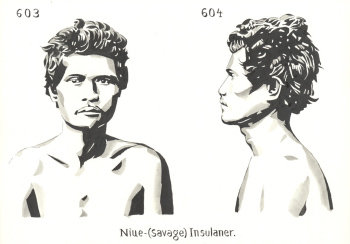Fernando Bryce
dal 23/4/2009 al 20/5/2009
Segnalato da
23/4/2009
Fernando Bryce
Museum Het Domein, Sittard
An Approach to the Museo Hawai. The artist gained international renown with his encyclopaedic installations of scores, sometimes hundreds, of simple ink works reconstructing specific happenings in world history. The black and white drawings are based on historic source material the artist culls. The title of the exhibition refers to an itinerant museum of curiosities known as Museo Hawai that Bryce saw as a child, and which has remained in his memory ever since.

Museum Het Domein is proud to present the first museum solo in the Netherlands of Peruvian-German artist Fernando Bryce (Lima, Peru, 1965). The artist gained international renown with his encyclopaedic installations of scores, sometimes hundreds, of simple ink drawings reconstructing specific happenings in world history. The black and white drawings are based on historic source material the artist culls. The artist refers to his artistic method as 'mimetic analysis': by selecting, copying with great precision and placing existing images in new contexts, Bryce reinterprets his sources. The archives and atlases he produces as a result of this method together present a confrontational and sometimes ironic view of colonial and imperial history, from worldwide revolutions and South American history, whether or not witnessed by the West. By underlining the complexity of the international network of socio-social, economic and political relations, Bryce continuously questions the way in which history is written and how our view of historic events is ideologically slanted, albeit unconsciously. The exhibition in Het Domein presents a small survey of exemplary works from the critical oeuvre of Fernando Bryce.
The title of the exhibition refers to an itinerant museum of curiosities known as Museo Hawai that Bryce saw as a child, and which has remained in his memory ever since. This macabre Kunst- und Wunderkammer which toured the back streets of Peru until fifteen years ago, held what was left of a didactic collection of materials that were used to train police detectives. The rather grim collection was once described by author Gustavo Buntix as 'a treasure-trove of aborted foetuses, ravages of venereal diseases, decomposed anatomies, and wax portraits of dictators and criminals where deathly likenesses of Hitler, Mussolini, Mao and Capone alternated'. In the Quechua language, the word 'hawai' means to gaze. Bryce considers the archive of imagery to which he is perpetually adding, a 'museum of the gaze': a place where different perspectives, views of history, ideologies and (stereotypical) images are deconstructed.
The most recent series of drawings by Bryce, Die Welt (2008), will be included this summer in an exhibition curated by Jota Castro during the Venice Biennial.
A comprehensive publication documenting the work of Fernando Bryce since 2005 will be published on the occasion of the exhibition. Containing many hundreds of images, an interview with the artist by Domein curator Roel Arkesteijn and an essay by writer Michaël Zeeman, the publication will be presented during a T-time on Sunday 14 June.
The opening of the exhibition of Fernando Bryce will take place on Friday April 24 from 17.00 to 19.00. At the same time Het Domein presents a small-scale exhibition: Nights, Winters, Years. Children select work from the collection, 18 April – 1 June 2009. See the accompanying invitations for details.
Press contact: Karin Adams & Roel Arkesteijn, +31 (0)46 451 3460; karin.adams@hetdomein.nl; roel.arkesteijn@hetdomein.nl
Opening: Friday April 24, 17 h.
Museum Het Domein
Kapittelstraat 6 - Sittard



